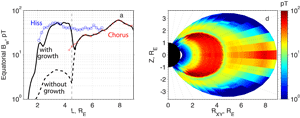
2012 THEMIS SCIENCE NUGGETS
Amplification of whistler-mode hiss inside the plasmasphere
by Lunjin Chen, UCLA AOS
Introduction
Chorus generated outside the plasmasphere has been suggested to be the source of plasmaspheric hiss. A detailed evaluation of the propagation and Landau damping of chorus waves can account for most of the properties of dayside hiss, but the intensity is underestimated by 10-20 dB compared to the observed hiss intensity. We show that this important discrepancy is due to the neglect of cyclotron resonant growth inside the plasmasphere.
Results
Figure 1 shows an example of simultaneous wave and electron measurements from the THEMIS E spacecraft in the prenoon sector. Hiss emissions are mainly seen in the frequency range below 1 kHz and confined to the high density. Electron distribution measured by ESA and SST inside the plasmasphere are anisotropic with peak phase space density at 90 degree pitch angle for the higher energies, especially for energies above 1 keV, indicating the potential for cyclotron growth of whistler mode waves.
| Figure 1. A THEMIS observation showing (a) plasma density derived from spacecraft potential, (b) electron energy flux from the ESA and SST instruments, (c) wave electric field and (d) wave magnetic field spectral intensity from fff data. In panels c) and d), dotted, dot-dashed, and solid lines represent fLHR, 0.1 fce and 0.5 fce. (e) The observed (solid lines) and fitted (dashed lines) electron pitch angle distributions inside the plasmasphere averaged over the time interval 0800-0820, indicated by the horizontal bar in between panels a) and b), for each energy level coded by color. |
In this study, for the first time we evaluate the ability of chorus waves to form the embryonic source of hiss together with the subsequent cyclotron resonant growth inside the plasmasphere. Figure 2a shows the comparison of simulation without the growth (dash black line) and with the growth (solid black line). Compared to the 5 pT amplitude from the simulation without growth, the simulation with growth reproduces a peak intensity of 50 pT, very close to the observed hiss intensity, over a broad region from L ~ 3 to just inside the plasmasphere, and also reproduces a strong drop at L ~ 2. Spatial confinement of hiss emission inside the plasmasphere is also reproduced in our simulation (Figure 2b).
| Figure 2. (a) The equatorial distribution of wave magnetic amplitude. The blue circles and red crosses represent the statistical distribution of hiss and chorus wave amplitudes observed on THEMIS near 10 MLT. Solid and dashed black lines represent the simulated wave amplitudes with and without internal hiss amplification, respectively. (b) Meridian distribution of simulated wave amplitude with hiss growth included. The dashed line in panel b represents the field line of plasmapause location. |
The simulated hiss spectrum depends on the source chorus distribution. For example, if the chorus source moves closer to the plasmapause, the hiss spectrum shifts to higher frequency (See comparison in Figure 3).
Conclusion
The access of chorus to form an embryonic source outside the plasmapause, together with internal amplification inside the plasmasphere using the observed electron distribution, can account for the spectral intensity of dayside plasmaspheric hiss.
References
Biographical Note
Lunjin Chen is a postdoctoral scholar at Department of Atmospheric and Oceanic Sciences, University of California, Los Angeles. His current research involves studying propagation and excitation of plasma waves in the magnetosphere (see http://www.atmos.ucla.edu/~clj/ for more information).
 Please send comments/suggestions to
Emmanuel Masongsong / emasongsong @ igpp.ucla.edu
Please send comments/suggestions to
Emmanuel Masongsong / emasongsong @ igpp.ucla.edu

